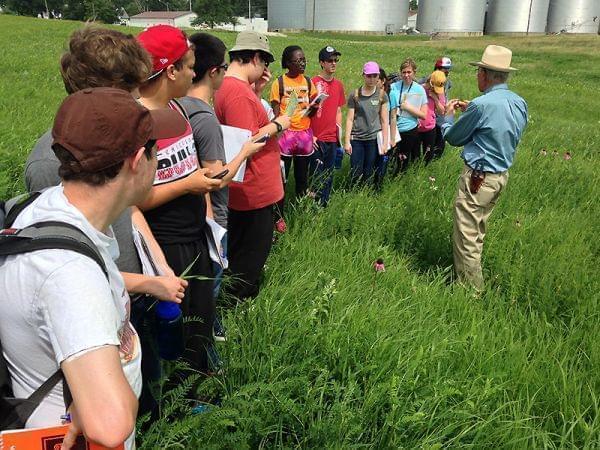Students in U of I summer program engage the “wicked” problem of sustainability

"Sustainable Futures" participants listen as Don Gardner describes his prairie project Rob Kanter
Can you save money for yourself and save the earth at the same time? That was the vexing challenge a group of high school students and incoming U of I freshman faced earlier this summer as they participated in a classroom exercise conducted by Jonathan Tomkin, a colleague of mine in the U of I School of Earth, Society, and Environment. Those who met the challenge got a chocolate bar; those who did not got nothing, so the game had a real consequence.
The point of the exercise, and an overall point of the course in which the students were participating, was to help them comprehend why sustainability is such a difficult goal for humanity. According to Tomkin, who also teaches college courses on the topic, “Sustainability is a ‘wicked problem, because cooperation doesn’t arise naturally in our efforts to address it, and it’s often not economically rational for individuals—or nations—to work to resolve it on their own.”
The students who took part in Tomkin’s game were on campus for a weeklong course called “Sustainable Futures” that was organized by the U of I Center for Global Studies. "Building a course around the subject of environmental sustainability was natural for us,” said Elly Hanauer, associate director for the Center. “It’s an issue that affects all of humanity and it’s also one our staff recognized would be interesting to motivated teens.”
To their credit, students remained engaged even though things got no easier in other classroom sessions. There, U of I faculty members introduced them to challenges ranging from national environmental policy and international negotiations on climate change, to the extinction crisis and ecosystem collapse.
Of course, some parts of the week were also devoted to showing participants the inventive ways faculty and others on the U of I campus are working to meet the sustainability challenges of the twenty-first century.
On the South Farms, we visited the field plots of the Energy Biosciences Institute, where research is conducted on second-generation biofuels. In addition, we made stops at the Student Sustainable Farm and the Woody Perennial Polyculture site, both of which seek to become economically viable, environmentally positive alternatives to conventional row-crop agriculture.
On an indoor trip, we got a behind-the-scenes-tour of the Business Instructional Facility with Guy Grant, an engineer who is part of the Retrocommissioning Team with UI Facilities & Services. That building, which opened in 2008, earned platinum status from the LEED certification program sponsored by the U.S. Green Building Council. Touring it with Grant enabled students to see for themselves the features that earned it that status, from the vegetation and solar panels on the roof to the sophisticated heating, cooling and ventilation equipment in the basement.
Because yours truly orchestrated the field trips for “Sustainable Futures,” the course had to include a trip to experience tallgrass prairie, the incredibly diverse ecosystem that once dominated the landscape of central Illinois. For this, we visited the prairie reconstruction Don Gardner established near Kempton, Illinois, in the mid-1970s and which he continues to improve and expand today.
What students retain from such a busy week varies enormously from one to the next. Some, I hope, will remember the beauties of prairie and why people like Gardner work so hard to protect and restore it. Others, I suspect, will recall only how hot the day was or how long it took for us to drive there.
In any case, participants in the “Sustainable Futures” course earned and hour of college credit and almost all of them expressed interest an attending other such events, “wicked problems” like sustainability notwithstanding.

